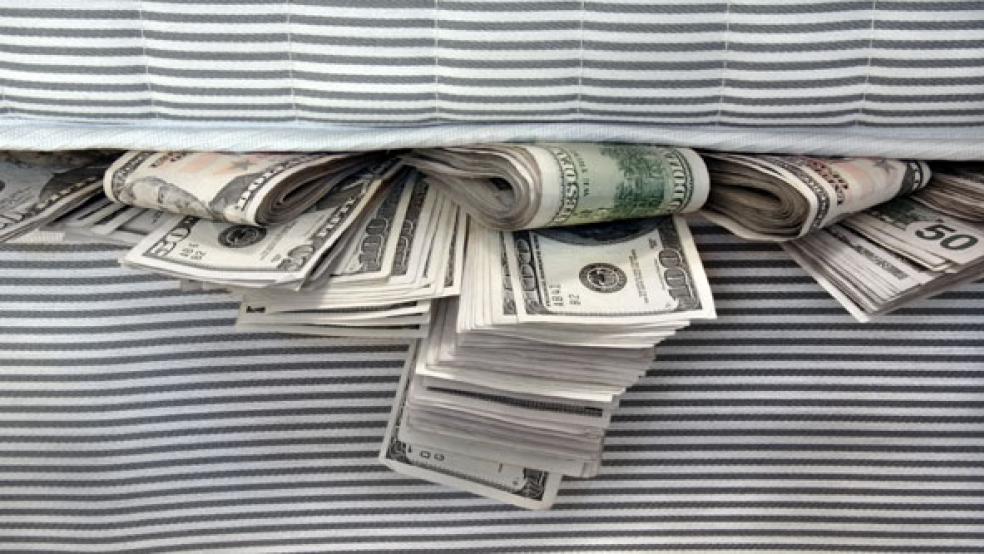What caused the Great Recession? The simplest explanation is too much debt. Too many first-time homebuyers bought houses they could not afford; too many homeowners used their bubble-inflated home equity like a piggybank; too many consumers maxed out on their credit cards.
The business and financial sectors engaged in their own debt binges during the 2000s. Too many companies used debt to buy back stock; too many banks made faulty loans; too many hedge funds used other peoples’ money to speculate in derivatives tied to collateralized debt obligations; and too many private equity firms borrowed to buy out companies.
RELATED: Voter Ignorance Threatens Deficit Reduction
When enough loans go bad, the excesses are exposed, the banks stop lending, and people and businesses reach the end of their credit rope. The bubble bursts. Then the contagion spreads. The only path forward is to stop spending, start paying off old bills and save. The process is known as deleveraging, which historical experience suggests is always longest and most painful after a debt-fueled financial crisis.
Consumers are unlikely to assume their historic posture as spender of last resort for the global economy
The U.S. is now in its fourth year of deleveraging in the wake of the 2007-08 credit collapse. And while there are growing signs that the process has reached the point where consumers can start spending again, a new report from the McKinsey Global Institute says U.S. consumers are unlikely to assume their historic posture as spender of last resort for the global economy.
“They probably won’t be as powerful an engine of global growth as they were before the crisis,” according to the report, Debt and deleveraging: Uneven progress on the path to growth. “One reason is that they will no longer have easy access to the equity in their homes to use for consumption.”
The report estimated that home equity loans and cash-out refinancing increased consumer spending by a percentage point to 3 percent growth a year during the housing bubble years. But with that source of debt financing gone, retailers are more likely to see 2 percent annual growth over the next few years, which is about where it has been in recent months.
That finding was echoed in the latest report from chief economist Diane Swonk of Mesirow Financial, who took a close look at the troubled housing sector. Even with a projected 18 percent increase in housing starts in 2012 and a 10.7 percent uptick in existing home sales, home prices nationwide are expected to fall another 2 to 4 percent this year as the deleveraging process continues.
The workforce is still suffering from 8 percent-plus unemployment and deteriorated credit ratings, and banks remain cautious about underwriting mortgages, she noted. The lingering impact of the Great Recession is turning America into a “renter nation,” and that will have major implications for the rest of the economy over the next few years.
“Renters and investors in rental properties do not tend to spend as much on upgrades, given the transient nature of renting,” she wrote. “It’s hard to justify big purchases of furniture and window treatments when you don’t know how long you will be living in a space.”
Still, the debt binge of the 2000s was a worldwide phenomenon, and the U.S. is way ahead of other advanced industrial countries in deleveraging its economy, the McKinsey report noted. U.S. households have reduced their debt-to-disposable ratio by 15 percentage points to about 110 percent, which is a greater reduction than any of the ten largest industrial economies over the last four years. “At this rate, they could reach sustainable debt levels in two years or so,” the report noted.
There are also signs consumers’ urge to spend is resuscitating. The latest Federal Reserve Board data showed that U.S. households upped their total debt by 0.3 percent in the fourth quarter of 2011, the first time since the second quarter of 2008 that total household debt increased. The $150 billion in reduced mortgage debt – deleveraging – was more than offset by the $170 billion in new consumer credit. Despite the increased debt, households’ debt-to-income ratio still went down because total income rose by an even greater percentage, not surprising given the improving employment picture.
But some economists see structural limits to how far deleveraging can drive the economy, especially since so much of the reduced mortgage debt is due to banks foreclosing on properties and writing off loans, not people paying off debts.
Thomas Palley, a labor movement adviser and associate at the New America Foundation, warns that only policies that promote full employment and lift household income can restore robust spending and growth. Reducing debt may reduce the numerator of the debt-to-income ratio, but it is less effective when the income denominator stagnates.
“Only another engine, the income distribution piece, will truly make this recovery self-sustaining,” said Palley, whose new book is called “From Financial Crisis to Stagnation.” Speaking at an Atlantic Magazine forum on Wednesday, he pointed out that “we’ve broken the link between productivity growth and wage growth. We’re heading for stagnation unless we address wage stagnation.”





